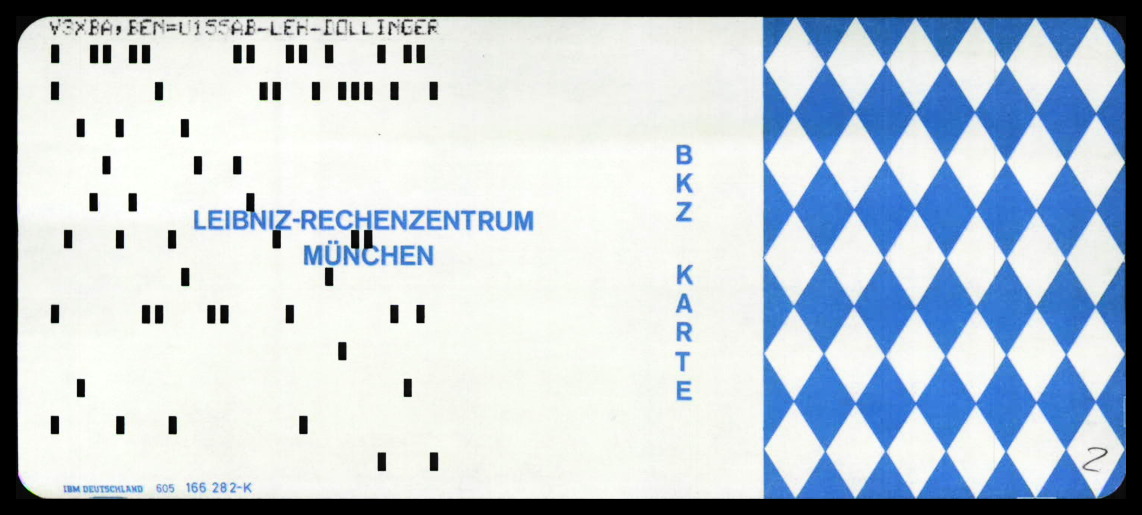

Punched Cards
Punched cards were omnipresent in EDP offices until the 1980s,
and they were used not only for computer data and program input,
but also for notes, reference cards, package slips, and many other purposes.
Today they have totally vanished, very few people still know of them,
and it is almost impossible to get hold of an original punched card.
Therefore, my collection of about 400 punched cards seems to be complete,
but I would be very happy to get or exchange any additional card.
How to collect Punched Cards
Like postage stamps, punched cards can be classified according to various criteria.
About 90% of all cards were rather ordinary and uninteresting like IBM's common
"digits card"
c0030.
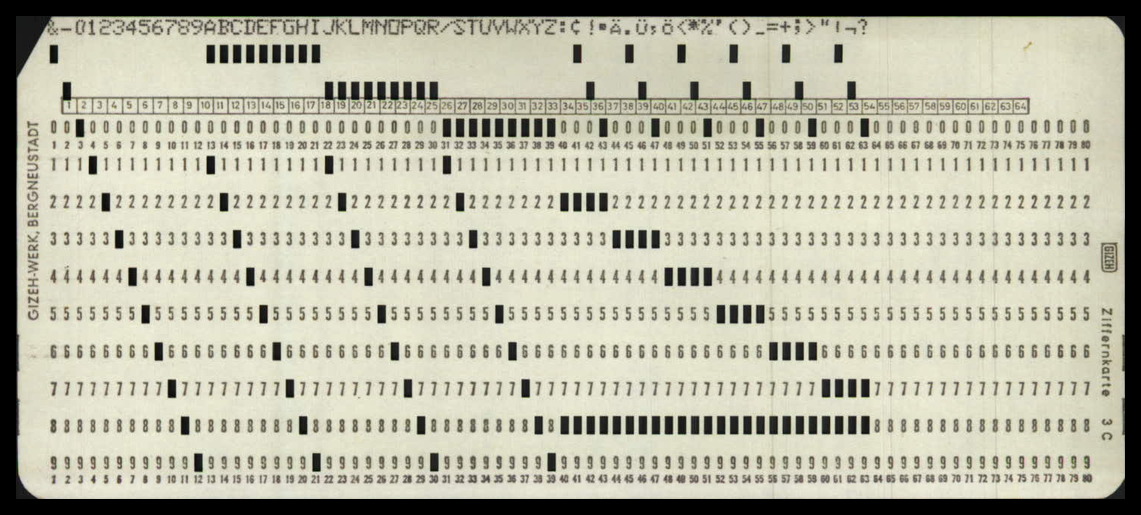 In this virtual museum the punched cards are ordered by the following
8
properties:
In this virtual museum the punched cards are ordered by the following
8
properties:
Plan of the Museum
The Virtual Punched Card Museum has
8
exhibition areas which each shows cards of the same category, as listed in the
previous section.
The following orientation tables shows the exhibition areas, their categories and the corresponding
values, and the number of cards with that value.
The link behind the value leads to the first card with that value.
Below the scanned mage of each card there is a table of the various properties
(country, purpose, paper etc.), together with links on the left and the right side.
The links invite to a tour showing the cards within the same category.

from Russia
|
| Country | |
295 |
| Australia | au |
1 |
| Switzerland | ch |
5 |
| Germany | de |
254 |
| Denmark | dk |
2 |
| France | fr |
3 |
| Israel | il |
1 |
| Italy | it |
5 |
| Netherlands | nl |
1 |
| Romania | ro |
2 |
| Russia | ru |
2 |
| United Kingdom | uk |
1 |
| USA | us |
8 |
| unknown | xx |
10 |
|
|

Melitta questionnaire
|
| Purpose | |
198 |
| Data | da |
91 |
| Data + Document | dd |
4 |
| Document | do |
8 |
| Identification | id |
10 |
| Information | in |
8 |
| Job Control | jc |
14 |
| Notiz | no |
7 |
| Programming | pr |
47 |
| Questionnaire | qu |
4 |
| Travel Ticket | ti |
5 |
|

IBM Greeting card
|
|

Volkswagen AG
|

VFW FOKKER
|

Univ. of Wisconsin
|
| Owner / User | |
197 |
| AEG-TELEFUNKEN |
1 |
| ALNO |
2 |
| BANCA GENERALE DI CREDITO |
1 |
| BMW |
1 |
| Bundeswehr |
2 |
| CENTRAAL REKENINSTITUUT |
1 |
| COMPAGNIE INTERNATIONALE POUR L'INFORMATIQUE |
1 |
| Christof Stoll KG |
25 |
| Control Data Rechenzentrum |
1 |
| DEGUSSA |
1 |
| DEUTSCHE LUFTHANSA AG |
1 |
| Dataset Limited |
1 |
| Deutsche Forschungs- und Versuchsanstalt für Luft- und Raumfahrt |
2 |
| E.P.L. |
1 |
| ECOLE POLYTECHNIQUE FEDERALE DE LAUSANNE |
1 |
| FACHHOCHSCHULE HAGEN |
1 |
| FIDES Rechenzentrum |
1 |
| Forschungsinstitut für Kinderernährung |
1 |
| GMD |
2 |
| Gesamthochschulbereich Dortmund Hochschulrechenzentrum |
4 |
| HUMMEL K.G. Magstadt |
1 |
| Hurth |
2 |
| IBM |
16 |
| IBM 7090 |
3 |
| IEEE |
2 |
| INSTITUT FÜR VERKEHRSPLANUNG |
1 |
| INSTITUT für PLASMAPHYSIK G.m.b.H. GARCHING |
8 |
| IOB Rechenzentrum GmbH |
1 |
| KA 1 Rhein-Neckar 1979 |
1 |
| LEIBNIZ-RECHENZENTRUM MÜNCHEN |
12 |
| LRZ MÜNCHEN |
1 |
| Landeshauptstadt München |
2 |
| Landtechnik Weihenstephan |
2 |
| MAN |
2 |
| MSD |
1 |
| Medizinische Universitätsklinik Tübingen |
3 |
| Melitta |
1 |
| NATIONAL |
1 |
| NEUCC |
1 |
| NORTHWEST AIRLINES |
1 |
| PRINCETON UNIVERSITY COMPUTER CENTER |
1 |
| PTT |
3 |
| R/S |
1 |
| RECHENINSTITUT DER TECHNISCHEN UNIVERSITÄT BERLIN |
1 |
| RECHENZENTRUM Justus Liebig-Universität Giessen |
1 |
| RECHENZENTRUM TECHNISCHE UNIVERSITÄT BRAUNSCHWEIG |
2 |
| RECHENZENTRUM UNI MAINZ |
1 |
| REGIONALES RECHENZENTRUM HANNOVER |
5 |
| RENK |
7 |
| RUHR-UNIVERSITÄT BOCHUM Rechenzentrum |
3 |
| Rechenzentrum der Universität Osnabrück |
1 |
| SBB |
2 |
| SNCF |
1 |
| Siemens |
18 |
| Stadthauptkasse München |
2 |
| TEL-AVIV UNIVERSITY - COMPUTATION CENTRE, FORTRAN |
1 |
| THE UNIVERSITY OF WISCONSIN COMPUTING CENTER |
2 |
| Technische Universität Hannover Rechenzentrum |
3 |
| Technische Universität München |
2 |
| U.S. DEPARTMENT OF COMMERCE |
1 |
| UNIVERSITÄT AUGSBURG |
1 |
| UNIVERSITÄT REGENSBURG |
1 |
| UNIVERSITÄT ULM |
1 |
| URZ MPI |
3 |
| Univ. Freiburg, Physik |
2 |
| Universität Karlsruhe Rechenzentrum |
3 |
| Universität Stuttgart |
1 |
| Universität zu Köln RECHENZENTRUM |
2 |
| VFW-FOKKER |
1 |
| Vera MICHAEL . DV-Service . 8060 Dachau |
1 |
| Volkswagen AG |
4 |
| Zentrale Rechenanlage der Philipps-Universität Marburg/Lahn |
1 |
| datacorrect |
2 |
| hoseit |
1 |
| softlab |
2 |
|

US Dept. of Commerce NTIS
|

Lufthansa receipt
|

informatik TU München
|
|

with microfilm
|
| Special Feature | |
16 |
| magnetic stripe | ms |
3 |
| special | ot |
2 |
| pencil markable | pm |
7 |
| precut holes | ps |
2 |
| tear-off | to |
2 |
|
|

IBM Test Centers
|
| Type of Organization | |
225 |
| commercial | co |
87 |
| EDP manufacturer | em |
43 |
| Research Institution | pc |
25 |
| Other Organization | po |
18 |
| University | uc |
52 |
|
|

TR440 Start of Job
|
| Paper Color | |
78 |
| blue | b |
27 |
| green | g |
2 |
| orange | o |
4 |
| pink | p |
1 |
| red | r |
25 |
| yellow | y |
19 |
|
|

COBOL Programming
|
| Color Stripe | |
24 |
| blue middle | bm |
1 |
| blue top border | bt |
3 |
| green diagonal | gd |
1 |
| green top border | gt |
5 |
| red diagonal | rd |
1 |
| red top border | rt |
8 |
| red upper third | ru |
1 |
| yellow top border | yt |
4 |
|
|

Hummel
|

PTT (ch)
|
| Card Manufacturer | |
269 |
| 3M |
1 |
| ARCO |
2 |
| BULL DE |
2 |
| BULL GENERAL ELECTRIC |
1 |
| CANTABCO |
2 |
| Capesent |
1 |
| Dataset 5/482-1 |
1 |
| Fleischhauer Datentraeger |
4 |
| Gizeh |
63 |
| Hummel |
78 |
| IBM |
9 |
| IBM CH |
2 |
| IBM DE |
74 |
| IBM DK |
2 |
| IBM IT |
4 |
| IBM Israel |
1 |
| MAGNETIC TICKET & LABEL CORP. |
1 |
| McCORQUODALE |
1 |
| National |
1 |
| Orgacard |
3 |
| PDC |
2 |
| PERFOCARTE NANCY |
1 |
| PTT |
3 |
| SBB |
2 |
| SIACO |
1 |
| W.Th.Webels, Essen |
1 |
| advanced |
1 |
| f+c datenträger |
1 |
| meco |
3 |
| raka |
1 |
|
|
Basic Properties of Punched Cards
Punched cards had the main purpose to enter information into a computer.
The information could be a program, data, or control commands.
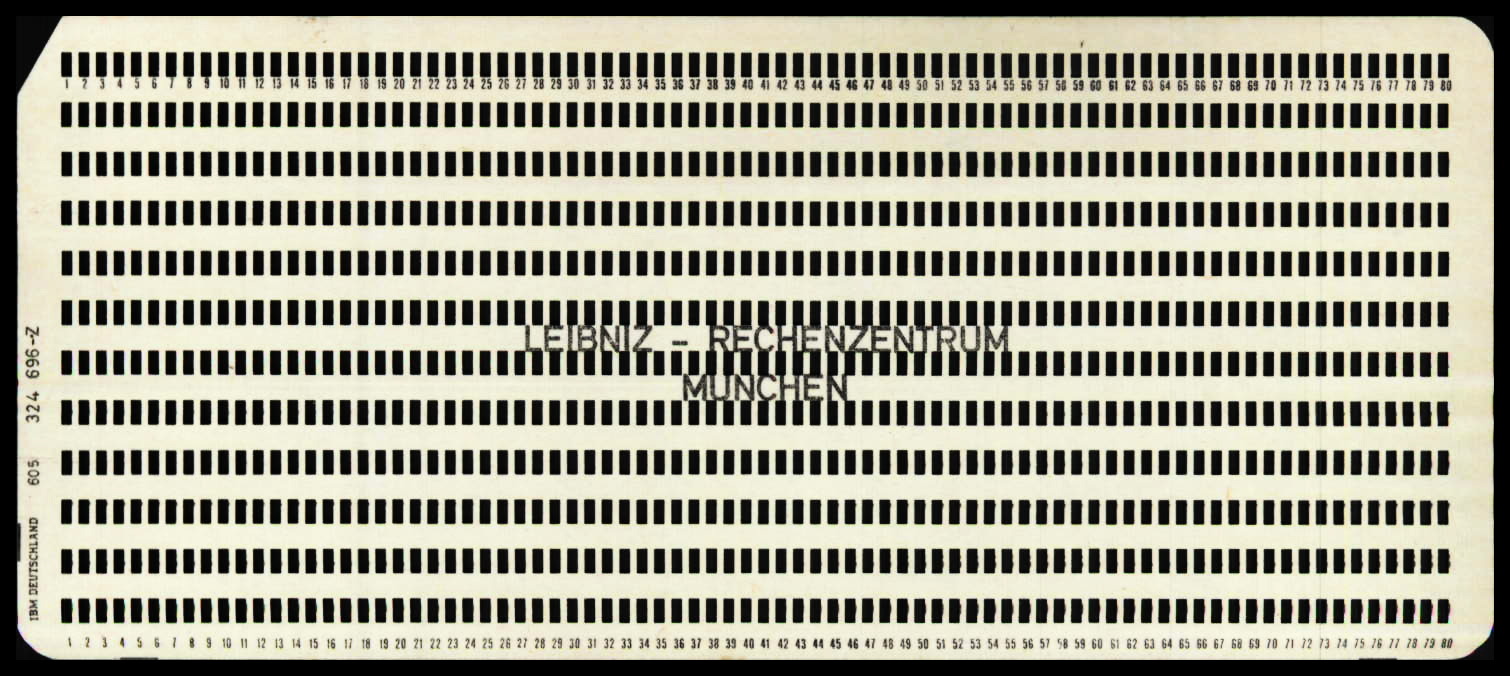
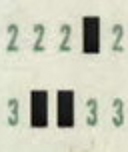 For the representation of the information, punched cards used
the same principle as their predecessor, the
punched paper tape as it was used in
telex machines.
A hole in the paper in some specific area of the stripe or card represents a bit 1,
while the absence represents a bit 0.
For the representation of the information, punched cards used
the same principle as their predecessor, the
punched paper tape as it was used in
telex machines.
A hole in the paper in some specific area of the stripe or card represents a bit 1,
while the absence represents a bit 0.
The standard card carried data in 80 columns (numbered 1 to 80). Each column could
have a punched hole in any of 12 rows. The rows were denoted in analogy to the
encoding for decimal digits, that is
"&"
(top row),
"-", "0", "1" ... "9"
(bottom row).
Digits had were encoded with 1 hole in a column, letters A-Z and "/" with 2 holes, and a set
of special characters with 3 holes (c.f.
c0093).
For binary data, a column could carry 0 to 12 holes. Depending on the computer's architecture,
a column could, for example, represent 2 characters of 6 bit or 1.5 characters of 8 bit.
Before the birth of IBM's /360 series which brought the byte, word lengths of multiples of 6 bit were
in rather widespread use. Examples which I used were the IBM 7040 (a special version
of the 7090, which was the successor of the IBM 709) with 36 bit words,
and the German Telefunken TR440 with 48 bit words.
With holes in 12 rows of 80 columns a punched card had a maximum storage capacity of
of 960 bit or 120 byte. A package of 100 cards thus stored about 12 Kilobyte of binary data,
while a modern external harddisk of roughly the same size and weight is able to store
1.2 Terabyte.
This is an increase of storage capacity by 100 millions during 40 years.
While a punched paper tapes contained one large, fixed block of information to be read
by the computer, it only allowed for linear, sequential punching
and reading.
Punched cards in contrast contained a small amount of information (up to 80 characters),
they could be punched, corrected, reordered and reused individually.
However, the computer still read the information sequentially from a batch of cards
like from a tape.
Punched Card Dimensions
Punched cards had a very standardized geometry, thickness and paper properties, since
they had to be reliably readable by punch readers at increasingly high
speeds over the years.
Paper
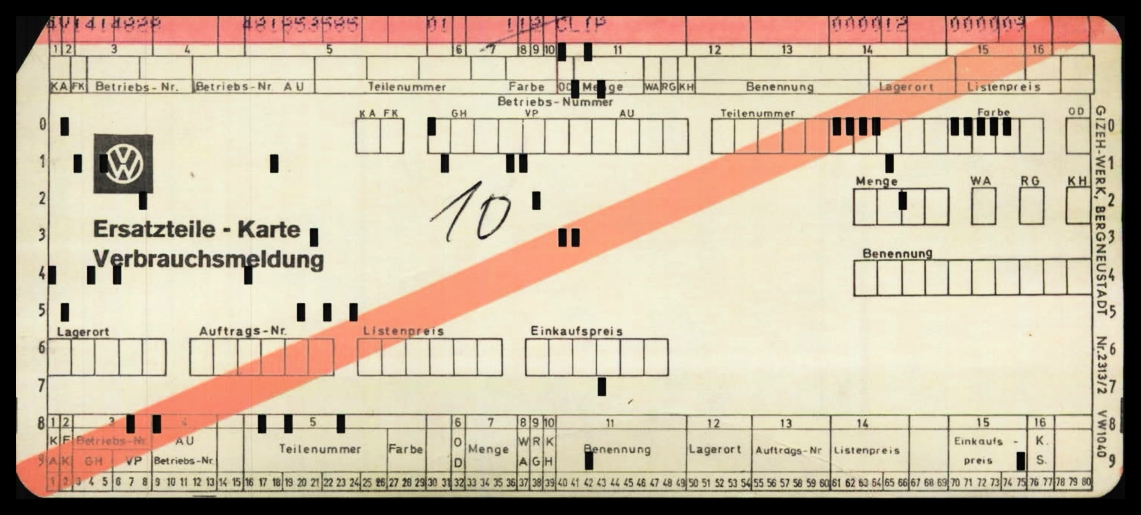 Ordinary cards had a lightyellow/natural color. Paper in other colors was used
for control cards, the start of a job etc.
Ordinary cards had a lightyellow/natural color. Paper in other colors was used
for control cards, the start of a job etc.
Color Stripes
Sometimes a color bar
was printed on the upper or lower edge, or diagonally across the card.
Compared to colored paper, such bars were cheaper to produce, and could
still serve to distinguish ordinary cards from special control cards.
Printing
The cards normally had some printing on the front side, while the back side
was blank.
The printed information was only meant for the human user, and with the exception
of pencil markable cards,
the automatic data processing only worked by detecting the holes in the card.
The printing had the following elements:
-
Form number
-
On most cards, there is a small print either on the left or right
edge which states the manufacturer (IBM and some specialized printers),
the card (type) number, and sometimes the city or the country of the print company.

-
Column numbers
-
Almost all cards to be punched for data processing showed the sequence of column numbers 1 to 80
in small print in an area between two punch rows.
The column numbers were relevant in most data formats and even in the programming languages
at that time, and it was very important for the typing person to be able to check the proper
column position of a character by visual inspection of the card.

Ordinary keypunch machines like the IBM 026 or 029 printed the coded character graphics
with a small dot matrix printer at the upper edge of the cards, directly above the
data column. In contrast, such a human readable printing was omitted when computer punched
data or (copies of) programs on blank cards. There were special - offline - machines which
could read the data and print the human readable text on the upper edge, but usually in
a font which was wider than the data column pitch. For these cases, some cards had an additional
column number sequence which gave the positions of the text characters, as shown by
c0029.

The printing in the punch area (12 rows with 80 columns each) varies from:
-
the digits 0 to 9 in all columns of row 0 to 9
-
digits in columns 0 to 9 with a logo of the company or organization
-
control cards for job start, job end etc. - these often had 4 round corners
-
margins for the column layout of programming languages (COBOL, Fortran etc.)
-
margins and explanations for application specific data fields
-
cards where columns could be marked with a soft pencil, or with perforated holes
to be stuck out with a pencil
-
special purpose cards with a second, non-EDP related purpose - cards carrying microfiches,
work time documents, cards for circuit control etc.
-
cards with the same size, but for human information only - short note cards, greeting cards, railway tickets,
libray catalogue cards, board cards etc.
There are logos on the cards of:
-
companies and commercial computer centers
-
universities
-
research institutions
Organization of the Virtual Punched Card Museum
Further Reading
Last modification: 24-Nov-2010
Please direct any questions or comments to:
<punctum@punctum.com>, Dr. Georg Fischer.

















 In this virtual museum the punched cards are ordered by the following
8
properties:
In this virtual museum the punched cards are ordered by the following
8
properties:


 Ordinary cards had a lightyellow/natural color. Paper in other colors was used
for control cards, the start of a job etc.
Ordinary cards had a lightyellow/natural color. Paper in other colors was used
for control cards, the start of a job etc.


